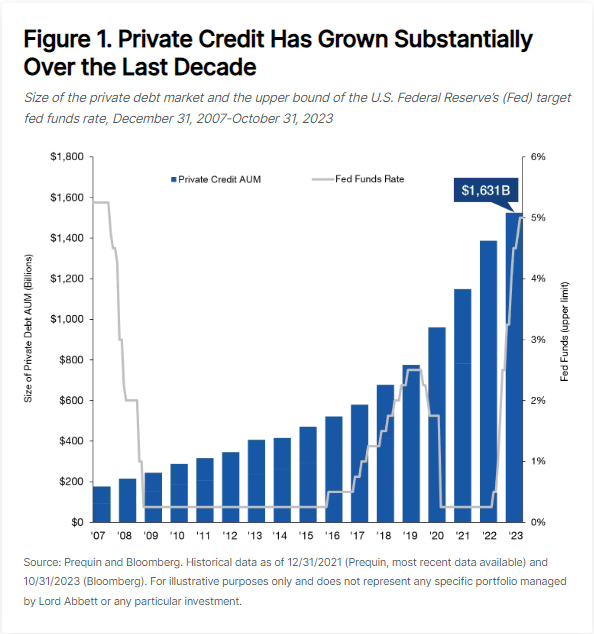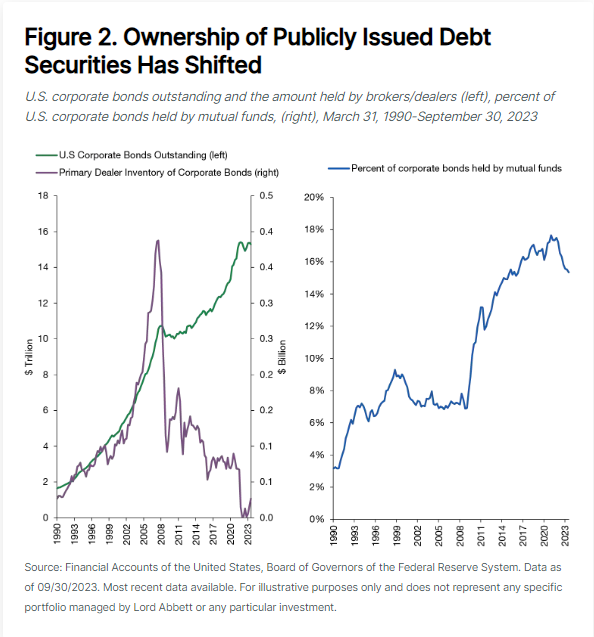Link para o artigo original:https://www.lordabbett.com/en-us/financial-advisor/insights/investment-objectives/opportunities-in-credit–an-active-approach-broadens-the-opportu.html
Opportunities in Credit: An Active Approach Broadens the Opportunity Set
The credit market landscape has evolved, and a focused credit approach may help investors navigate it.
![]() By Andrew Fox Investment Strategist
By Andrew Fox Investment Strategist
Key Points
- Capital markets have adapted to changing liquidity mechanisms brought about by well-intended regulations.
- These adaptations result in more frequent and extreme changes in flows, creating opportunities for a flexible credit manager.
- A focused credit strategy that seeks to identify idiosyncratic ideas in the new liquidity landscape may provide a broader opportunity set to potentially source better alpha-generating investments.
Following the Great Financial Crisis (GFC), regulators have worked to build a framework of laws designed to limit the emergence of market conditions like those that contributed to the GFC. These laws, such as the Dodd-Frank Wall Street Reform and Consumer Protection Act, reduced the appetite for risk taking for many market players, and helped to create the credit market liquidity mechanisms of today.
Against this backdrop, which continually evolves with each episode of market stress, an active and deep credit approach may capitalize on select opportunities. A focused credit investment thesis that identifies idiosyncratic opportunities across a broad set of credit sectors expands the potential for alpha-generating ideas.
Q: How has the landscape for fixed income changed?
Andrew Fox: At its core, the GFC was driven by that original sin of finance: asset and liability mismatching. Banks by their nature generally fund longer-term lending with short term deposits. When credit markets ceased to provide liquidity, market participants such as banks, which financed investments through borrowings, were forced to unwind positions in a disorderly fashion. This same dynamic, similar in nature if different in detail, plays out periodically; two recent examples include the pension crisis in the United Kingdom (UK) in 2022 and the regional banking crisis in the United States (U.S.) in the spring of 2023.
Regulators continue to adjust rules to limit, if not avoid, these episodes. On the horizon is Basel III Endgame, which is the most recent update to the regulations developed by the Basel Committee on Banking Supervision. Basel III Endgame includes far-reaching changes to banks’ risk-based capital frameworks. Potential changes to Securities and Exchange Commission (SEC) Rule 22e-4, which pertains to liquidity risk management programs adopted by 40-Act mutual funds, are also forthcoming.
Capital markets have adapted to these changes, but not without major modifications. One of the largest has been well-exploited by investors, particularly in the institutional space—the rise of private credit. Borrowers have many reasons for seeking to place their debt privately, but one of the most significant may be the unwillingness of traditional banking channels to extend credit at a level and with terms borrowers find attractive.

Public debt markets have also expanded to fill the void of bank financing. Looking at the size of the U.S. corporate bond market, the amount outstanding today is three times the size of the market before the GFC. But the holders of these securities have changed dramatically, with dealers holding 80%-90% fewer corporate bonds in inventory than prior to the GFC. Mutual funds and exchange-traded funds (ETFs) have grown by roughly four times over the same period. These structures offer a high degree of liquidity, while investing in long-dated instruments, so they’re theoretically mismatched as well and, as such, each must manage flows amid a market of participants managing the same liquidity needs.

Q: How might higher rates change this new liquidity environment?
Fox: What’s different between 2020 and today is that, while regulatory and legislative efforts globally have limited the amount of risk financial institutions hold on their balance sheets, chiefly through higher capital charges, the impact has been somewhat blunted by a historically prolonged period of low rates. With the apparent ending of ZIRP (zero interest-rate policy) the impact of restrictions, current and proposed, may be more fully felt. Additionally, with competition for depositor dollars from higher-yielding options such as money markets and the Fed’s continued quantitative tightening, banks may become even more reluctant to hold debt on their balance sheets.
For banks, the implications go beyond limiting further purchases and may extend into outright sales of existing holdings, including those originally earmarked to be held to maturity. Some of those asset sales will take creativity on behalf of buyer and seller and will in many cases be difficult for traditional fixed-income investors to participate in. Taken together, this represents both a curtailment of demand and a meaningful source of potential supply of fixed-income instruments.
Q: How can credit strategies manage in this environment?
Fox: Clearly, the appetite for rolling back the regulatory framework is low, given the current queue of scheduled and proposed changes. We think the new liquidity regime will remain.
One way to potentially take advantage of this landscape is to do what private credit investors have done: step into the shoes of market actors who have, for reasons already discussed, stepped away. Traded credit offers opportunity as well. With the right structure and the right investors, strategies can provide liquidity to market participants when periods of dislocation or capital shortages occur, acting in a sense as the new risk intermediary.
There are several ways to do this, and there’s no shortage of strategies standing up to try to capture one part or another of this dynamic. Some are focused on pricing dislocations—generally at a market or asset-class level—and offering capital during periods of stress to reap the benefits as markets “normalize.” Others are focused purely on liquidity premiums—building a portfolio of off-the-run instruments and hoping to capture liquidity premiums over time. Each of these approaches has its merits, but they tend to be dependent upon macroeconomic catalysts or sector/asset class specific dislocations that may be sporadic and limit the opportunity set.
We believe an optimal approach is to narrowly focus on specific instruments, specific investments, and specific stories, while viewing the dislocation as setting the table for opportunity, but not representing the central thesis for investment. The appeal of this investment-by-investment strategy is the broadening of the opportunity set that is evergreen rather than episodic. By focusing down to the line-item level, opportunities within a sector, an industry, an asset class, or a company, become much more frequent. There is also the added benefit of not basing a thesis around a macroeconomic outcome or seeking to benefit from a broad mean reversion within a sector or asset class. Instead, the investment thesis focuses on the specific structure of the security or company. The macro role, again, is limited to being an additional factor toward setting the valuation table.
Q: How can credit investments play a role in an existing asset allocation?
Fox: We believe opportunistic credit can enhance an investment program in several ways. First, as a complement to private credit, we believe opportunistic credit is a great fit philosophically, as well as practically. Philosophically, the investor has already allocated to a space, which was also once dominated by banks, to directly capture value. Opportunistic credit strategies allow the investor to step in where traditional holders of risk, such as the capital markets desks at investment banks, or more recently the balance sheets of regional banks, have stepped away or have been forced away by regulatory capital pressures.
In addition to feeding from the same vacuum of competition, opportunistic credit complements private credit in a practical sense because private credit, by design, does not trade or price actively. In contrast, opportunistic credit strategies have an eye toward early monetization of good investments as the investment thesis plays out. While strategies should hold securities that are deemed attractive to maturity, it is also appealing to have the option to realize a gain and recycle the capital into a new idea when the market has caught up to your views.
As part of an overall asset allocation, credit may also provide diversification benefits to equity risk, especially in a new, higher rate and inflation environment. Credit has historically diversified rate risk by remaining negatively correlated to rates. In this sense, the role of credit becomes even more significant in terms of earning a strong return but with a lower level of risk than equities, as measured by standard deviation. Credit may also provide access and exposure to different risk premiums and sources of return, especially in a strategy that seeks idiosyncratic opportunities without the constraint of a benchmark. If you think about it simply as “who gets most of the cash flows?”—for years that was titled toward the bottom of the structure due to the rate environment. That has changed—noted earlier possibly for good—if the last 23 years turn out to have been an aberration. With the internal rate of return (IRR) opportunities we’re seeing in fixed-income markets, credit is making a very strong case for recapturing some of the allocation weights it lost during ZIRP.
Summing Up
Our view is that, as part of a credit allocation, an optimal strategy to consider is an active manager with deep credit expertise that can start with a blank piece of paper. Although there is an investment universe dictated by the manager’s resources and experience, in our view a superior approach to credit means not thinking in terms of indexes or buckets. Rather, the investment thesis is about maximizing the return potential for the risk the instrument represents. Today, selection is as important as it has ever been. Properly tailored and situated, we believe it is possible for multi-asset or opportunistic credit to deliver a risk experience in line with traditional index-tracking strategies, while delivering a return experiencing that is vastly different.
As informações aqui contidas estão sendo fornecidas pela GAMA Investimentos (“Distribuidor”), na qualidade de distribuidora do site. O conteúdo deste documento [e informações neste site] contém informações proprietárias sobre LORD ABBETT e o Fundo. Nenhuma parte deste documento nem as informações proprietárias do LORD ABBETT ou DO Fundo aqui podem ser (i) copiadas, fotocopiadas ou duplicadas de qualquer forma por qualquer meio (ii) distribuídas sem o consentimento prévio por escrito do LORD ABBETT. Divulgações importantes estão incluídas ao longo deste documento e que devem ser utilizadas exclusivamente para fins de análise do LORD ABBETT e do Fundo. Este documento não pretende ser totalmente compreendido ou conter todas as informações que o destinatário possa desejar ao analisar o LORD ABBETT e o Fundo e/ou seus respectivos produtos gerenciados ou futuramente gerenciados. Este material não pode ser utilizado como base para qualquer decisão de investimento. O destinatário deve confiar exclusivamente nos documentos constitutivos de qualquer produto e em sua própria análise independente. Nem o LORD ABBETT nem o Fundo estão registrados ou licenciados no Brasil e o Fundo não está disponível para venda pública no Brasil. Embora a Gama e suas afiliadas acreditem que todas as informações aqui contidas sejam precisas, nenhuma delas faz qualquer declaração ou garantia quanto à conclusão ou necessidades dessas informações.
Essas informações podem conter declarações de previsões que envolvem riscos e incertezas; os resultados reais podem diferir materialmente de quaisquer expectativas, projeções ou previsões feitas ou inferidas em tais declarações de previsões. Portanto, os destinatários são advertidos a não depositar confiança indevida nessas declarações de previsões. As projeções e/ou valores futuros de investimentos não realizados dependerão, entre outros fatores, dos resultados operacionais futuros, do valor dos ativos e das condições de mercado no momento da alienação, restrições legais e contratuais à transferência que possam limitar a liquidez, quaisquer custos de transação e prazos e forma de venda, que podem diferir das premissas e circunstâncias em que se baseiam as perspectivas atuais, e muitas das quais são difíceis de prever. O desempenho passado não é indicativo de resultados futuros.

